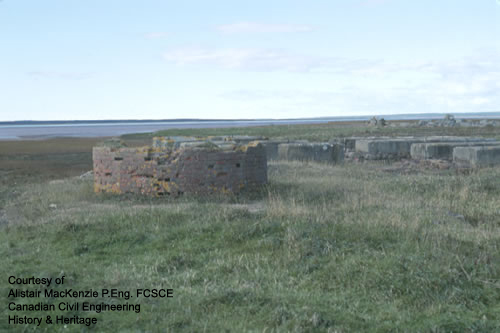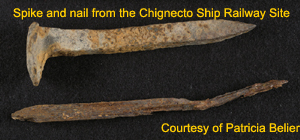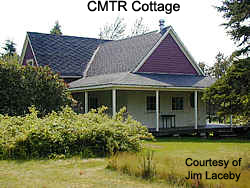

Contents
The Chignecto Marine Transport Railway Company Inc.
Factors Contributing to
the Failure of the Project
Prime Ministers in Office during
the Project
Political Supporters of the Project
The Remnants of Chignecto
Chignecto Housing
Published
Articles
Canal Studies
| ◆ Henry George Clopper Ketchum | Managing Director |
| ◆ Edwin Clark | Inventor of the
Lifting Docks to be used at Chignecto |
| ◆ Thomas Coltrin Keefer | Civil Engineer |
| ◆
Charles R. Coker |
Lloyd’s Surveyor of Shipping Saint John and Quebec |
| ◆ R.G. Lunt | Steamship Owner |
| ◆
William Elder, M.P.P. |
Leader of the House, New Brunswick and Provincial Secretary |
| ◆
Charles C. Gregory, C.E. |
Toronto |
| ◆
Col. Charles J. Stuart |
Amherst, afterwards of Halifax |
| ◆
Christopher Milner |
Barrister (Ketchum’s Father-in-law) |
| ◆
Hon. P.A. Landry |
Judge, Supreme Court, New Brunswick |
| ◆
Hon. C.J. Townsend |
Judge, Supreme Court, Nova Scotia |
| ◆
James S. Hickman |
Merchant, Amherst |
| ◆
W.D. Douglas |
Merchant, Amherst |
| ◆
W.D. Main |
Amherst |
| ◆
J.C. Brundage |
Shipmaster |
| ◆
William C. Milner |
Former owner and Manager Joggins Railway (Ketchum’s Brother-in-law) |
| ◆
W.H. Marston |
New York |
| ◆
Hon. J.S. Carvell |
Former Governor, Prince Edward Island |
| ◆
Hon. A.W. Ogilvie |
Senator |
| ◆
John H. Parkes, C.E. |
Manufacturer, New Brunswick |
| ◆
Hon. A.E. Killam, M.P.P. |
Manufacturer, New Brunswick |
| ◆ Thomas Wood | President |
| ◆
Col. Pagent Mosley |
Vice President |
| ◆
Andrew Dryburgh Provand, M.P. |
Director (later became President) |
| ◆
W.H. Campbell |
Director |
| ◆
A.R. Robertson |
Director |
| ◆
Arth Serences |
Director |
| ◆
Henry Kendrick |
Secretary of Chignecto investors group |
| ◆
Fletcher F.S. Kelsey |
Resident Engineer |
| ◆
J.S. Armstrong |
Principal Assistant |
| ◆
Maurice Fitzmaurice |
Assistant |
| ◆
S.J. Symonds |
Inspector |
| ◆
J.B. Dennison |
Hydraulic Works |
| ◆
G.F. May |
Hydraulic Works |
| ◆
J.F.
O’Rourke |
Engineer |
| ◆
George Buchanan |
Engineer |
| ◆
Arthur Bateson |
Agent for the Chief of Contractors |
| ◆
Scottish Engineers |
Supervised the building of the stone culvert near the Tidnish Bridge |
| ◆
Dawson, Symmes and Ussher, Ontario |
Earthwork
and masonry for the railway lines and docks; dredging,
plate-laying and ballast, breakwaters |
| ◆
Easton and Anderson |
provision and installation of hydraulic machinery |
| ◆
Rhodes and Curry, Amherst |
construction of buildings to house machinery, and pine sleepers for Dawson and Company |
| ◆
Harris and Company, Saint John |
cradle wheels |
| ◆
Canadian Locomotive Company, Ontario |
heavy tank locomotives |
| ◆
Approximately 4000 workers |
majority from Quebec, Italy and Ireland |

 Work ceased on the Chignecto Ship Railway in 1891. A.D. Provand, representative of the Chignecto Marine Transport Railway Co. shareholders, continued to press the Canadian government to resume work on the project up until his death in 1914. The onset of WWI in 1914 demolished any hope of resurrecting the project. Over time the railway has been systematically dismantled and its materials used for a number of ventures: |
|
| ◆ | The
Chignecto Marine Transport Railway Company sold rails and
fastenings from the Chignecto Railway to the Canadian Government for
use on the Intercolonial Railway. |
| ◆ |
Cape
Tormentine, New Brunswick, and Borden, Prince Edward Island, used a
large portion of the heavy
rock from the railway site in construction of their ferry approaches. |
| ◆ |
Sleepers were salvaged and cut into lumber, much of which was used to build several houses in the vicinity of the railway. |
| ◆ |
The
machinery used for constructing the railway was sold for scrap. |
| ◆ |
The
brick used to construct the Power House now forms part of the firewall
in the Fort Beauséjour Museum, Aulac, New Brunswick. |
| With the
influx of so many workers (up to 4,000) into the Chignecto
area to work on the Ship Railway, the towns of Sackville and Amherst
underwent a commercial boom. Immigrant workers from Quebec, Italy
and Ireland, as well as engineers, site management, businessmen and
visitors, had to be housed. Many new buildings were erected in Amherst and on the Fort Lawrence Marsh: |
|
| ◆ |
Henry
George Clopper Ketchum set up his business office at Amherst.
Later the Ketchums constructed a home at Tidnish, which is now used as
a summer rental accommodation. |
| ◆ |
The
engineers employed on the Chignecto Railway also set up their
headquarters in Amherst. Their residence was known as “BallyHooly
House” due to the large amount of entertaining carried out there. |
| ◆ |
A
home was built by Rhodes, Curry Ltd. of Amherst for Fletcher F.S.
Kelsey, Resident Manager and Engineer of the Chignecto Ship
Railway. The house was purchased in 1910 by C.E. Trenholm
who moved it to Upper Fort Lawrence. |
◆ |
 The CMTR (Chignecto Marine Transport Railway) Cottage was constructed for the use of workers on the Chignecto Ship Railway. It has been suggested that the building was used as a cookhouse, but this cannot be confirmed. |
| ◆ |
Labourers’
Barracks were built in various locations around the Ship Railway
works. The sites of all the barracks are not known but there were
two built near the Fort Lawrence terminal. One of the residences
consisted of two long narrow buildings, which, in the 1940s were being
used by Mr. Harley Smith to house pigs. |
| ◆ |
The
Italians had their own barracks in a large hollow beside the
railroad. The smoke from their morning breakfast fires gave rise
to this location being known as “Smokey Hollow”. |
| ◆ |
The
inhabitants of Fort Lawrence had been unable to buy goods in their town
since the closing of the one local store owned by Thomas
Roach. With the Ship Railway came the opening of at least
two stores, one managed by C.R. Church, that sold a large range of dry
goods, fabrics and groceries. |
| ◆ |
Several
private boarding houses, hotels, and stables were also erected to
accommodate business and company officials, interested visitors, and
travelers. |
Sources:
Atkins, Pearl MacD. “The history of Tidnish Bridge”. Amherst Citizen, 4th January, 1986.
Trenholm, Gladys et al. A
history of Fort Lawrence - Times, Tides and Towns.
Edmonton: Sherwood Printing Ltd., 1985
| From 1686 to 1875 at
least 18 Canal studies/surveys were carried out on the Isthmus of
Chignecto, but prior to Ketchum’s Ship Railway project, no work had
ever been started. Some examples of previous
studies/surveys are: |
|
1686- 1687 |
Jacques de Meulles of Quebec made a tour of inspection of Chignecto, proposing that a canal be built from the Bay of Fundy to Baie Verte on Northumberland Strait. |
1783 |
Colonel Robert Morse, Chief of Royal Engineers, suggested a canal as a vital defence in any future military struggle. |
1808 |
Robert Minette was employed by the New Brunswick government to survey the Isthmus of Chignecto as a possible route for a canal. |
1811 |
Civil Engineer Francis Hall was commissioned to prepare a report on the construction of a canal at Chignecto. |
1826 |
Thomas Telford, founder of the Institution of Civil Engineers (UK), prepared a report on the Isthmus of Chignecto. |
1843 |
H.O. Crawley undertook a feasibility study of a canal at Chignecto and reported that it would be a favourable undertaking. |
1869 |
The government of Nova Scotia formed a company to build a canal as a private venture but no progress was ever made. The governing political party in Nova Scotia changed. The new government commissioned another report, the results of which were unfavourable. |
1875 |
Henry George Clopper Ketchum proposed a ship railway as an alternative to a canal to cross the Isthmus of Chignecto. |
Since the demise of the Chignecto Ship Railway project, two further canal studies were carried out on the Isthmus of Chignecto; one in 1931 and another in 1958. Neither study led to any actual construction. |
|